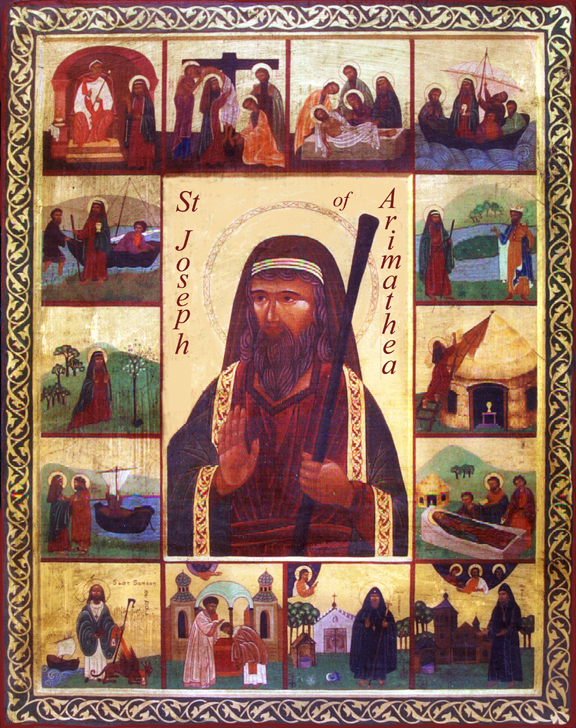
A Brief History of the Celtic Orthodox Church
Origins
The Celtic Church is one of the oldest in the Christian world. By tradition it was founded by Saint Joseph of Arimathea in 37AD, in Britain, in a place which is now called Glastonbury. In AD63, another disciple, Saint Aristobúlus, also came to Britain. In six centuries, all the British Isles were Christianised.
This church, which spread across much of the Romano-Byzantine Empire, kept the freshness of the Apostolic Church. She was free of all temporal power, poor, and extraordinarily dynamic with numerous monasteries. From Ireland to Scotland, Brittany and to the borders of Europe, thousands of Celtic monks carried a spirituality which, following the first fathers of the West, were a glory in the first millennium of the Christian era. Such great names as Patrick, Brigit, Columba, Brendan, Samson, Amand, Fare, Columban and many others stand out in the history of our Church.
The Celtic Church began its decline after the Synod of Whitby in AD664 when the established Celtic way was challenged by the growing Roman Church. The key issue for the Synod was to settle the way the date of Pascha/Easter was calculated. But much more was at stake. The more deeply spiritual Celtic way, based on a monasticism tradition received from the Early Fathers was at odds with the more rigid and organised Roman way. Thanks to the eloquence of St Wilfred over the less articulate proponents of the Celtic position the Roman Church won the day and the Celtic Church began to dwindle until by the 13th century it was lost.
Restoration
The restoration of the Celtic Church began in 1866, by the grace of one inspired man, Bishop Julius (Jules Ferrette), and the intuition of a Metropolitan Bishop of the Syrian Orthodox Church, Mar Boutros (Boutros ibn Salmo Mesko), who later became Patriarch Peter-Ignatius IV. The consecration of Bishop Julius by Mar Boutros was witnessed by the British Consul at Damascus. Bp Julius was given the title of Bishop of Iona and its Dependencies.
Bishop Julius was sent to Britain to form an indigenous Orthodox Church in Western Europe, which was not in any way subject to the Syrian Orthodox Church or the Patriarch of Antioch. The Church, which is autocephalous, was initially known as the Ancient British Church. In 1874 Bp Julius appointed Bp Pelagius I (Richard Williams Morgan) as the first Patriarch of Britain.
In 1944, as a result of merging with other Orthodox/Catholic groups the Church became known as the Catholicate of the West, but this was short-lived (dissolved in 1953), after which the Church was known as the Orthodox Church of the British Isles. A list of the successive Patriarchs is given farther on.
Whilst Bishop Georgius I (Hugh George de Willmott Newman) was Patriarch (1945-1979) an interest in rekindling a Celtic spirituality was growing in France. Jean-Pierre Danyel (1917-1968), having explored many denominations in his spiritual journey, was baptised into the Orthodox Church in 1949 and received the monastic tonsure. In 1953 he was received into the Orthodox Church of the British Isles and ordained priest. In 1955, Father Danyel settled in a boggy wooded area called Bois-Juhel in Saint-Dolay (Morbihan, Brittany), forming a simple hermitage where he developed his Celtic spirituality. In 1956 he was persuaded to head the newly formed Holy Celtic Church of Brittany (note – he did not found it) and in 1957 he was consecrated Bishop, taking the name Tugdual. Bishop Tugdual stayed at Saint-Dolay until just before his death in 1968.
Meanwhile a small group of spiritual seekers from Southern France, headed by Brother Paul-Eduard de Fournier de Brescia, took monastic vows and were received into the Orthodox Church of the British Isles in 1974. Fr Paul was ordained priest. In 1977 the three monks moved to Saint -Dolay and inhabited the hermitage which had lain abandoned since Bishop Tugdual’s death. It was very basic, but gradually the Monastery of the Holy Presence was developed. In 1980 Fr Paul was consecrated bishop by the then Patriarch, Abba Seraphim (William Henry Hugo Newman-Norton), taking the name Mael.
Bishop Tugdual had left copious notebooks expounding his neo-Celtic spirituality, and, building on these, and his deep devotion to St Francis of Assisi, Bishop Mael initiated profound reforms in the Church regaining its (historic) Celtic traditions, Rites and spirit.
Parting of the Ways
Patriarch Abba Seraphim had discussions with Pope Shenouda of the Coptic Orthodox Church and he, along with Bishop Mael and Bishop Marc, visited Pope Shenouda, following which, in 1994, most of the UK branch of the Orthodox Church of the British Isles joined the Coptic Orthodox Church, changing its name to the British Orthodox Church. The French branch of the Orthodox Church of the British Isles, considering their mission was better served by remaining as they were, did not follow Abba Seraphim into the Coptic Church. Therefore, on the departure of Abba Seraphim, the Holy Synod of the remaining Church elected Bishop Mael (Paul-Eduard de Fournier de Brescia) as Primate. The Church was renamed the Celtic Orthodox Church. Susequently, some of the UK clergy who had followed Abba Seraphim into the Coptic Church asked to return to their original Church and were received into the Celtic Orthodox Church by Metropolitan Mael. It is deeply sad to record that there was considerable friction between the Celtic Orthodox Church and the British Orthosdox Church in the late 1990s.
It is clear that the Celtic Orthodox Church and the British Orthodox Church share a common heritage derived from Jules Ferrette. Consequently, the Community of St Gwenn's maintains an amicable reltionship with Abba Seraphim and his Church. In 2015 the British Orthodox Church left the Coptic Church resuming an independant status.
